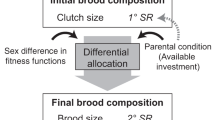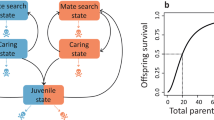Summary
To understand the evolution of parental care behaviour, the cost of care must be evaluated in terms of lost reproductive potential. Using population genetics theory, a quantitative model of parental care is presented here to evaluate the allocation of resources between production and care of offspring, and care of grandoffspring. The results show that the evolutionarily stable investment ratio of resources to offspring versus grandoffspring is equal to 2∶1. The expected investment in grandoffspring will decrease when there is a lower probability of survival of the parents to a late stage of the life cycle. These results are discussed in the context of general life history theory, inclusive fitness models, animal behaviour field studies, and the evolution of human menopause.
Similar content being viewed by others
References
Altmann, S. A. (1979) Altruistic behaviour: the fallacy of kin deployment.Anim. Behav. 27, 958–62.
Armitage, K. B. and Downhower, J. F. (1974) Demography of yellow-bellied marmot populations.Ecology 55, 1233–45.
Boorman, S. A. and Levitt, P. R. (1980)The Genetics of Altruism, Academic Press, New York.
Charlesworth, B. (1980)Evolution in Age-Structured Populations, Cambridge University Press, New York.
Cheney, D. L. and Seyfarth, R. M. (1986) The recognition of social alliances by vervet monkeys.Anim. Behav. 34, 1722–31.
Dawkins, R. (1976)The Selfish Gene, Oxford University Press, New York.
Fairbanks, L. A. and McGuire, M. T. (1986) Age, reproductive value, and dominance-related behavior in vervet monkey females: cross-generational influences on social relationships and reproduction.Anim. Behav. 34, 1710–21.
Gadgil, M. and Bossert, W. H. (1970) Life historical consequences of natural selection.Am. Nat. 104, 1–24.
Guthrie, R. O. (1969) Senescence as an adaptive trait.Perspect. Biology Med. 12, 313–24.
Hamilton, W. D. (1964) The genetical evolution of social behavior. I & II.J. Theoret. Biol. 7, 1–52.
Hamilton, W. D. (1966) The moulding of senescence by natural selection.J. Theoret. Biol. 12, 12–45.
Harper, L. V. (1981) Offspring effects upon parents. InParental Care in Mammals (D. J. Gubernick and P. H. Klopfer, eds), pp. 117–78. Plenum Press, New York.
Holmes, W. G. and Sherman, P. W. (1982) The ontogeny of kin recognition in two species of ground squirrels.Am. Zool. 22, 491–518.
Hoogland, J. L. (1986) Nepotism in prairie dogs (Cynomys ludovicianus) varies with competition but not with kinship.Anim. Behav. 34, 263–70.
Jolly, A. (1985)The Evolution of Primate Behavior, MacMillan Publishing Company, New York.
Kurland, J. A. (1977) Kin selection in the Japanese monkey.Contrib. Primatol. 12, 145.
Kurland, J. A. and Gaulin, S. J. C. (1984) The evolution of male parental investment: effects of genetic relatedness and feeding ecology on the allocation of reproductive effort. InPrimate Paternalism (D. M. Taub, ed.), pp. 259–308. Van Nostrand Reinhold, New York.
Massey, A. (1977) Agonistic aids and kinship in a group of pigtail macaques.Behav. Ecol. Sociobiol. 2, 31–40.
Mayer, P. J. (1982) Evolutionary advantages of the menopause.Hum. Ecol. 10, 477–94.
Maynard Smith, J. (1977) Parental investment: a prospective analysis.Anim. Behav. 25, 1–9.
Maynard Smith, J. and Price, G. R. (1973) The logic of animal conflict.Nature (Lond.) 246, 15–18.
Medawar, P. B. (1952)An Unsolved Problem in Biology. H. K. Lewis, London. (Reprinted in Medawar, 1957).
Medawar, P. B. (1957)The Uniqueness of the Individual. Methuen, London.
Miyadi, D. (1967) Differences in social behavior among Japanese macaque troops. InNeve Ergebnisse der Primatologie (D. Stark, R. Schneider, and H.J. Kuhn, eds.). Fisher, Stuttgart.
Morris, M., Matessi, C. and Karlin, S. (1987) Models of intergenerational kin selection.Am. Nat. 130, 544–69.
Nalepa, C. A. (1988) Cost of Parental Care in the woodroachCryptocercus punctulatus Scudder (Dictyoptera: Cryptocercidae).Behav. Ecol. Sociol. 23, 135–40.
Schaffer, W. M. (1974) Optimal reproductive effort in fluctuating environments.Am. Nat. 108, 783–90.
Schaffer, W. M. and Rosenzweig, M. L. (1977) Selection for optimal life histories. II. Multiple equilibria and the evolution of alternative reproductive strategies.Ecology 58, 60–72.
Schaller, G. B. (1977)Mountain Monarchs. Chicago Press, Chicago.
Schulman, S. R. and Rubenstein, D. I. (1983) Kinship, need, and the distribution of altruism.Am. Nat. 121, 776–88.
Tallamy, D. W. and Denno, R. F. (1982) Life history trade-offs inGargaphia solani (Hemiptera: Tingidae): the cost of reproduction.Ecology 63, 616–20.
Trivers, R. L. (1972) Parental investment and sexual selection. InSexual Selection and the Descent of Man (B. Campbell, ed.), pp. 136–79. Aldine, Chicago.
Turke, P. W. and Betzig, L. L. (1985) Those who can do: wealth, status, and reproductive success on Ifaluk.Ethol. Sociobiol. 6, 79–87.
Visscher, P. K. (1986) Kinship discrimination in queen rearing by honey bees (Apis mellifera).Behav. Ecol. Sociobiol. 18, 453–60.
Waldman, B. (1981) Sibling recognition in toad tadpoles: the role of experience.Z. Tierpsychol. 56, 341–58.
Waser, P. M. (1978) Postreproductive survival and behavior in a free-ranging female mangabey.Folia Primatologie 29, 142–60.
Weigel, R. M. (1981) The distribution of altruism among kin: A mathematical model.Am. Nat. 118, 191–201.
Wells, K. D. (1981) Parental behavior of male and female frogs. InNatural Selection and Social Behavior: Recent Research and New Theory (R. D. Alexander and D. W. Tinkle, eds), pp. 184–97. Chiron Press, New York.
Williams, G. C. (1957) Pleiotrophy, natural selection, and the evolution of senescence.Evolution 11, 398–411.
Williams, G. C. (1966) Natural selection, the costs of reproduction and a refinement of Lack's principle.Am. Nat. 100, 687–90.
Wright, S. (1922) Coefficients of inbreeding and relationship.Am. Nat. 56, 330–8.
Wu, H. M. H., Holmes, W. G., Medina, S. R., Sackett, G. P. (1980) Kin preference in infantMacaca nemestrina.Nature (Lond.) 285, 225–7.
Author information
Authors and Affiliations
Rights and permissions
About this article
Cite this article
Roach, D.A. Parental care and the allocation of resources across generations. Evol Ecol 6, 187–197 (1992). https://doi.org/10.1007/BF02214161
Issue Date:
DOI: https://doi.org/10.1007/BF02214161




